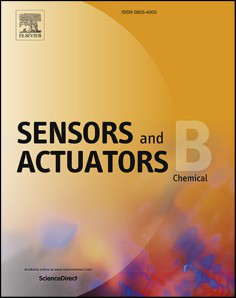Ling zang original research ideas and plans


 |
Contents lists available at ScienceDirect | |
| journal homepage: |
* Corresponding author.
** Corresponding author at. Nano Institute of Utah, University of Utah, Salt Lake City 84112, UT, USA. E-mail addresses: (S. Chen), (L. Zang).
Ideally, molecular dispersion of the fluorescence sensors or probes on the solid surface is deemed critical for maximizing the reactivity with the gaseous analytes, and thus the detection sensitivity. Moreover, in order to reach low LOD the solid substrate used for supporting the flu-orophores must be in porous structure with large open surface area in order to afford maximal absorption of gas species. Especially for the gaseous analytes in very trace level that is undetectable by normal chemical sensors, such porous substrate may help pre-concentrate the species in the matrix (depending on the exposure time) so as to reach the detectable level for the fluorescence sensors deposited therein. To the regard of practical application, a sensor based on solid state materials is usually conducive to fabrication as a portable or even wearable device that is easy to be used by itself or integrated into the current air moni-toring system for quick detection of airborne pollutants [12–16,18].
The concept of combining chemical sensing with pre-concentration in a single material system as mentioned above has recently been proven with a paper-based colorimetric sensor for formaldehyde recently developed from our lab [30]. The sensing mechanism is based on the specific aldimine condensation reaction between amine and formaldehyde forming the corresponding Schiff base. The amine used is hydroxylamine in the format of sulfuric acid salt, for which the pro-tonated amine provides much faster reaction with aldehyde than the free base amine. As a result of the condensation reaction, sulfuric acids (protons) are released and this can be easily detected with pH indicators as revealed by the color change. By incorporating the hydroxylamine salt and pH indicators into the matrix of paper towel (a low cost sub-strate possessing open porosity), an effective sensor was developed for gaseous detection of formaldehyde. To further improve the detection sensitivity, glycerin was also used as an additive to enhance the
used in the immersion solution was varied (at 0 %, 5 % and 10 % volume ratio), and the effect on the sensing response in terms of the fluorescence increase was investigated. The comparative results would help deter-mine the optimal condition for the coating of glycerin as described below.
2.3. Generation of gaseous formaldehyde and testing for the sensor plate
3
C. Liao et al. Sensors and Actuators: B. Chemical 375 (2023) 132861
4
C. Liao et al. Sensors and Actuators: B. Chemical 375 (2023) 132861
To explore the limit of detection (LOD), the sensor plate was exam-ined by exposure to various concentration of formaldehyde (0 −900 ppb) for 20 min. For each concentration, the increase in fluorescence intensity at 550 nm was measured, and plotted as a function of the concentration. Assuming that a quasi-equilibrium was reached within 20 min of exposure (as implied from the result shown in Fig. 2), the data shown in Fig. 3 should follow the Langmuir adsorption model (See the Supporting Information). After fitting the data with the Langmuir equation, the LOD of this sensor plate was projected to be 3.7 ppb by defining an intensity increase of 3 times the standard deviation of measurement as the detectable signal. It is worth to note that the LOD obtained is more than twenty times lower than the air quality threshold (80 ppb) set for formaldehyde by the WHO.
In addition to the high sensitivity, the sensor plate also demonstrated excellent selectivity towards formaldehyde against other common gases and chemicals as shown in Fig. 4. While significant fluoresce increase was obtained upon exposure to 9 ppm formaldehyde, almost no response was observed for all the ten references tested under the same condition despite that the concentrations of the references were 10–70 times higher than that of formaldehyde. Such a drastic difference
| C. Liao et al. | References | |
|---|---|---|
| present in gas phase. |
4. Conclusions
We have developed a simple, but efficient fluorescence turn-on sensor for highly selective detection of formaldehyde in gas phase. The sensing mechanism is based on the specific aldimine condensation reaction between formaldehyde and hydroxylamine sulfuric salt, which in turn releases the acid. The released acid then protonates the aniline group modified on a PDI molecule, and turns on the characteristic fluorescence of PDI. All the sensor components are incorporated in the porous matrix of a cellulose plate, which provides large open surface for capture and adsorption of gas analytes. Quantitative detection of formaldehyde can be realized simply by measuring the increase in fluorescence intensity of PDI. The sensing response towards formalde-hyde was found in the time range of secs. Fast response paves the way for a sensor to be applied in realtime detection, especially in the scenarios like monitoring of air pollution or public safety. The LOD of the sensor is projected as 3.7 ppb, which is significantly lower than the safety threshold of formaldehyde (80 ppb) set by the WHO, meaning that the sensor developed will be capable of reliable monitoring of airborne formaldehyde. More strikingly, the sensor demonstrated highly specific response towards formaldehyde with almost no interference from other common gases or chemicals (e.g., organic solvents). Combination of the high sensitivity and selectivity provides the sensor great potential for future application, not only in air quality monitoring, but also in many other areas such as medical diagnostics where formaldehyde may be produced as a biomarker. The main innovation of this work derives from the integration of the reaction specificity of aldimine condensation re-action, the high sensitivity of fluorescence response, and the porous structure of cellulose matrix, so as to enable high sensor performance as expected. The design and optimization strategy developed for the sensor composite is extensible to other materials and fluorophores to enable detection of broad range of other air pollutants or chemicals of interest.
Data Availability
Data will be made available on request.
6
C. Liao et al. Sensors and Actuators: B. Chemical 375 (2023) 132861
[33]
[34]
[39] r
[40] r
7






